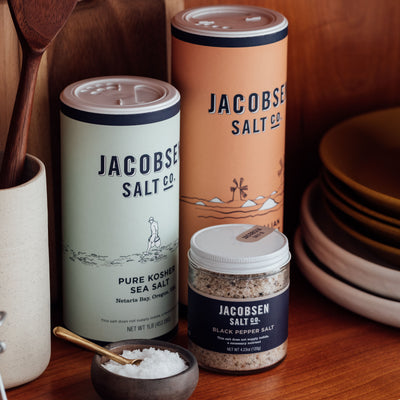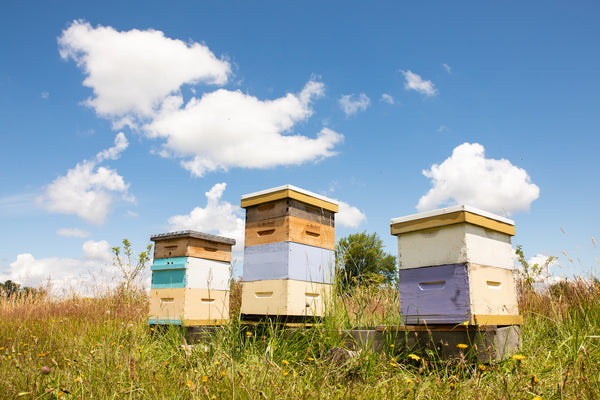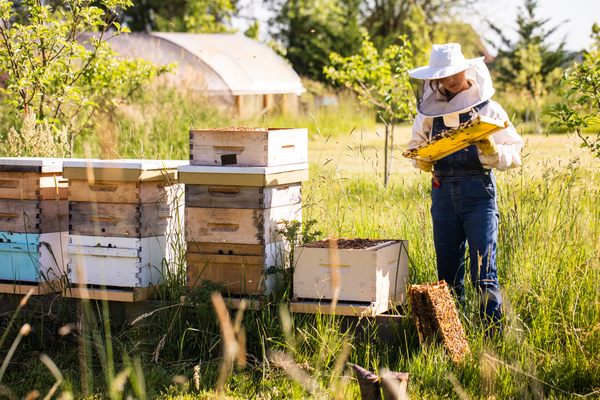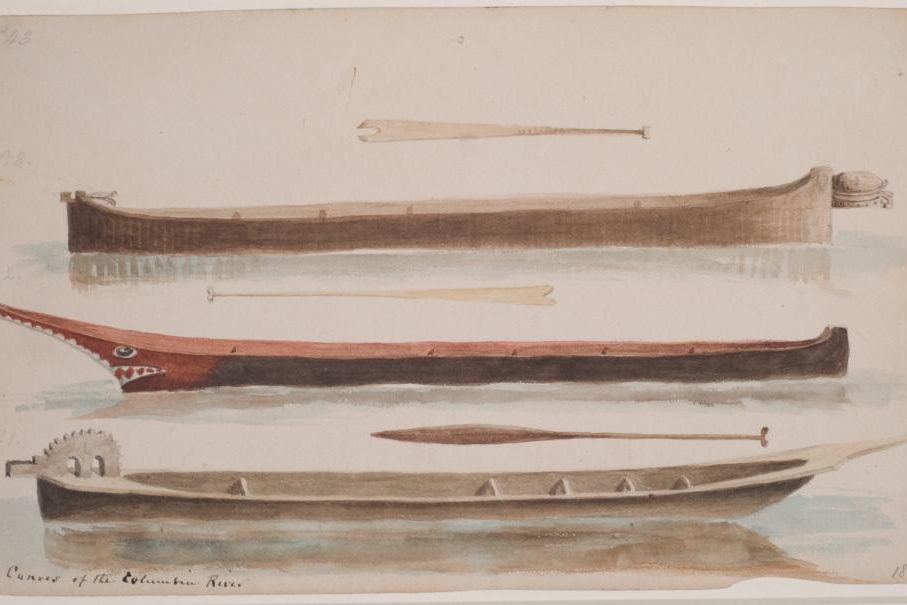
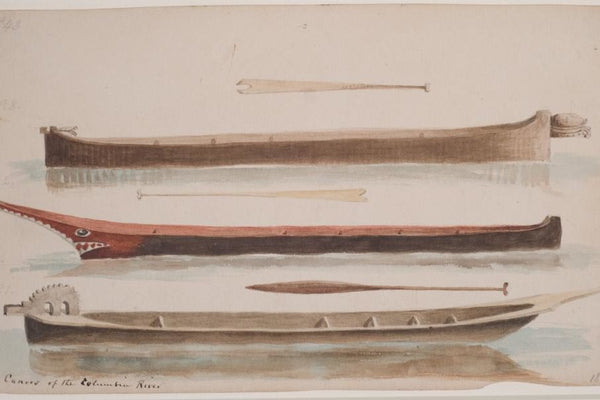
9-Course Spiel: The Elakha Alliance's Chanel Hason & Peter Hatch
Posted by:
Jacobsen Salt Co.
Posted on:
Aug 11, 2023
It's been two years since we first teamed up with the Elakha Alliance for our 10th Anniversary, where we launched a special edition slide tin to help raise awareness and funds for their mission of restoring Oregon's population of sea otters and strengthening our local marine ecosystem. This year, we're thrilled to be revisiting this partnership with the debut of our 2023 Limited Edition Sea Otter Slide Tin!
We caught up with the Elakha Alliance's Director of Outreach and Community Relations, Chanel Hason, to see what their team's been working on:
1. Can you give us a quick refresher on what the Elakha Alliance is?
(CH): Did you know that sea otters used to live along the entire West Coast from Baja, Mexico all the way up the continental US to Japan? Starting in the late 1700's, sea otters were hunted for their fur and became locally extinct in Oregon by 1910. The Elakha Alliance is a non-profit based in Oregon working to return sea otters back to their native waters along our coastline. We are composed of tribal leaders, researchers, and conservationists who want to reintroduce sea otters back to Oregon's coast for their cultural significance with coastal tribes, and their ecological and economic benefits.
2. What has Elakha Alliance been up to since our last collaboration in 2021?
(CH): Wow, we have been busy since our original partnership in 2021.
-
We hired an Executive Director in July of 2022 and a Coastal Community Coordinator in July 2023
-
In early 2022, we published a Scientific Feasibility Study on sea otter reintroduction in Oregon, as well as an Economic Impact Assessment
-
We had our first Tribal Youth Internship with two tribal college students from the University of Oregon who created a traveling display highlighting the cultural significance of sea otters in Oregon
-
We held our first Oregon Otter Beer Festival in 2022, and it was such a successful fundraiser that we made it an annual event and had another Otter Beer Fest in Portland in 2023
-
Most recently, we published a South Coast Tourism Impact Study which resulted in an estimated 3.5 million per year increase with the presence of sea otters with ecotourism
3. Do you have any big initiatives or events coming up?
(CH): We are funding research on assessing shark presence in potential sea otter reintroduction areas in Oregon and also working on translocation planning with wildlife experts and partner organizations. We have Sea Otter Awareness Week coming up in late September, as well as the Elakha Alliance's annual Sea Otter Science Symposium in October. Our 3rd annual Otter Beer Festival will be held in April 2024 in Portland again, so stay tuned!
4. For people looking to help, how can they get involved with the Elakha Alliance?
(CH): People can help by visiting OregonSeaOtters.org and becoming a monthly donor for as little a $5 a month. These funds help us continue our efforts as the sole organization whose mission is to return sea otters back to Oregon. They can also sign up to receive our monthly newsletter the Raft, purchase any of our sea otter merch, or invite us to come speak to their school or organization.
5. Do you have a fun sea otter fact you can share?
(CH): Sea otters can see just as clearly on land as they do underwater! Sea otters can squeeze their lenses through their pupils into a more rounded shape when diving. The more rounded shape bends the light more, which compensates for the reduced bending affected by water, and light properly reaches the retina, enabling a clear image.
To learn more about the Elakha Alliance, check out the original 2021 discussion with Chanel Hason and Peter Hatch below!

This week, the Elakha Alliance’s highly-anticipated Feasibility Study Draft was released to the public, which explores the many facets of a proposed sea otter reintroduction in Oregon. We chatted with the Alliance’s Chanel Hason and Peter Hatch about key takeaways from the study, the history of sea otter reintroduction, and what comes next.
1. Can you speak more to the cultural and historical significance of the sea otter to the people and waters of the Oregon Coast? What would reintroducing sea otters mean from that standpoint?
(PH): From time immemorial until just a few generations ago, people living on this coast have shared their waters with sea otters. On a purely practical level, sea otters were valuable to our people for their warm, lush fur -- the archaeological record is clear that our ancestors sustainably hunted them for thousands of years. On a deeper level they are our relatives, a part of the web of interconnections that we have always relied upon for our prosperity; they are a missing but cherished part of the fabric that makes the Oregon Coast our home.
2. Can you talk about the ecological significance of the sea otter and what reintroducing them to the Oregon Coast would mean?
(CH): Sea otters are known as a keystone species in the kelp forest ecosystem, like polar bears are in the Arctic, because they are critical to how an ecosystem functions. For instance, sea otters eat numerous sea urchins, which eat kelp in large abundance. When sea urchins' populations are controlled by sea otters, vital kelp forests can flourish.
We are currently witnessing a drastic decrease in kelp forests abundance along the West Coast. One factor could be that two top predators of sea urchins, sea otters and sunflower sea stars, are absent from the majority of these marine ecosystems. The Oregon Kelp Alliance (ORKA) is working on urchin culling in 5 permitted locations along the Oregon coast to help decrease the multi-million number of sea urchins left unchecked. We’re hoping that tied with ORKA’s efforts, that a reintroduction of sea otters could prove beneficial at reinvigorating the kelp forests in Oregon.
We know sea otters have been present for at least 10,000 years along our Oregon waters, but have been absent for over a century because of the fur trade. No one can predict fully what would happen after a planned reintroduction because so many factors are at play in regards to wild animals. But, our initial findings are proving very positive for a successful reintroduction based off of decades of research from six leading scientists who authored our Feasibility Study.
3. Where did the sea otters go?
(PH): Oregon is just a part of the broader story of the North Pacific, where sea otters were very nearly hunted to extinction for the commercial fur trade, from the 1740s through 1911 when they were protected by the North Pacific Fur Seal Treaty. Just a year before those protections were signed, the last recorded Oregon sea otter was killed. In other parts of their range sea otters hung on or have been successfully reintroduced, but the Oregon Coast sits in the middle of a stubborn 800-mile gap in their natural range.
4. How and when did the Elakha Alliance form? Why sea otters and why now?
(PH): The roots of the Elakha Alliance go back to 1998, when my late father Dave Hatch wanted to name a boat we’d built, and ran across E-lak’-ka in an old Chinook Jargon (now usually called Chinuk Wawa) dictionary. That brought up some questions, and led down a path of talks, activism, and connecting people to raise awareness and get some of the preliminary research done. He passed in 2016, but a few of us got together and wanted to try to carry the work forward.
Although our lands and waters have been greatly affected by our management and mismanagement in the last couple of centuries, and many many of the species that make Oregon the place it is are under severe strain, we’re lucky that most are still present in our place. Sea otters are one of the few species that belong here that we’ve lost completely - with their return we have a chance to make special places in our ecosystem more resilient, to better weather the many severe challenges coming at us.
5. What is a trophic cascade? Have we seen what happens when sea otters are removed from a habitat? Do they really have that much of an impact?
(CH): Trophic cascades are powerful indirect interactions that can control entire ecosystems. Trophic cascades occur when predators limit the density and/or behavior of their prey and thereby enhance survival of the next lower trophic level. Hence, sea otters (predators) control the population of sea urchins (prey) in the kelp forest ecosystem.
The influence of sea otters on coastal ecosystems is one of the most well-known and well-documented examples of a trophic cascade. The top-down effects of sea otters on coastal ecosystems result mostly from the direct limiting influences of sea otters on their macro-invertebrate prey and through the indirect effects on other species and ecological processes. The most extensively studied and well-known effect of sea otters occurs through their limiting influence on sea urchins and the resulting enhancing effect on kelps and other groups of macro-algae, which in turn affects numerous other species and ecological processes.
So the answer is YES! Sea otters have a huge effect on the ecosystem. When sea otters are removed from that ecosystem, their prey are often left unchecked to graze upon every kelp frond in sight. This creates an ecosystem out of balance, which is what we are witnessing on much of the West Coast with sea urchin barrens.

6. If the fur trade essentially wiped out the sea otter population all the way from the Aleutian Islands to California, why are there otters in Southern California, and from Puget Sound to Alaska? Have sea otters been reintroduced before? If so, what sort of impact have we seen from these reintroductions?
(CH): Over the past 80 years, nearly 1,000 sea otters have been captured, held, transported, and released into unoccupied habitats to restore populations. These translocations have occurred to repopulate areas ranging from Alaska to California, with many successful populations still thriving. I encourage you to review Chapter 2 of our Draft Feasibility Study to read about the history of translocations of sea otters across the globe and their impacts.
7. Since this is not the first time Oregon has tried to reintroduce sea otters, what may be different this time?
(CH): Sea otters returned briefly to the Oregon coast in the early 1970s when nearly 100 animals captured in the Aleutian Islands were released at Cape Arago (40 animals in 1971) and Port Orford (29 animals in 1970, 24 animals in 1971). They were captured because the Aleutian Islands were going to become a government bombing testing site, so scientists had to think quickly about saving these precious marine mammals.
Some animals appear to have soon left the area of their release, while others did not. Even though pups were subsequently reported in some places, the entire population of animals declined dramatically by 1975 and disappeared by 1981 for reasons that are still not well understood. Sea otters remain absent on the Oregon coast except for an occasional stray individual, perhaps from the Washington population.
During this same time period of 1969 – 1972, other sea otters were captured in the Aleutian Islands and relocated to the coasts of Washington, British Columbia, and southeast Alaska, forming the basis of populations that exist today.
Thankfully, there has been decades of research and successful translocations that we can learn from for a future attempt off of the Oregon coast. You can take a deeper dive into this topic in Chapter 2 of our Feasibility Study.
8. What are some of the concerns people have with reintroducing this marine mammal? Potential barriers the Alliance may face in getting buy-in?
(CH): With any translocation effort, there will be pros and cons. Currently we are working very closely with those stakeholders, mainly the crab and fin-fishing industries, with addressing their potential concerns and coming up with the best solutions for all involved.
We have reached out to and discussed concerns with the Oregon Dungeness Crab Commission; we have held two webinars with crabbers to explore issues. We will be working with the West Coast Seafood Processors Association to address the concerns it expressed in a recent letter to the US Fish and Wildlife Service. We intend to seek changes in federal regulations that guide post-release management of sea otters so that future problems with sea otters can be resolved as they arise.
9. The Impact and Feasibility Study will be released soon - what information/highlights would you say we should take from that?
(CH): Restoring a population of sea otters on the Oregon coast is feasible if steps are taken to account for ecological, habitat, logistic, economic, and social factors highlighted in this Feasibility Study. There appear to be no insurmountable ecological, habitat, physiological, logistical, or regulatory barriers to restoring a population of sea otters in Oregon. Read more here.
10. Once the study is published, what comes next? At this moment, how long do you think a sea otter reintroduction will take and what will it take to achieve the Alliance’s vision?
(CH): We published the draft of the scientific Feasibility Study on our website on August 30, 2021 for the public to give feedback for three months. This gives stakeholders and individuals an opportunity to pinpoint and voice anything that they feel we haven’t addressed in our research. The study is scheduled to be completed by the end of January 2022.

